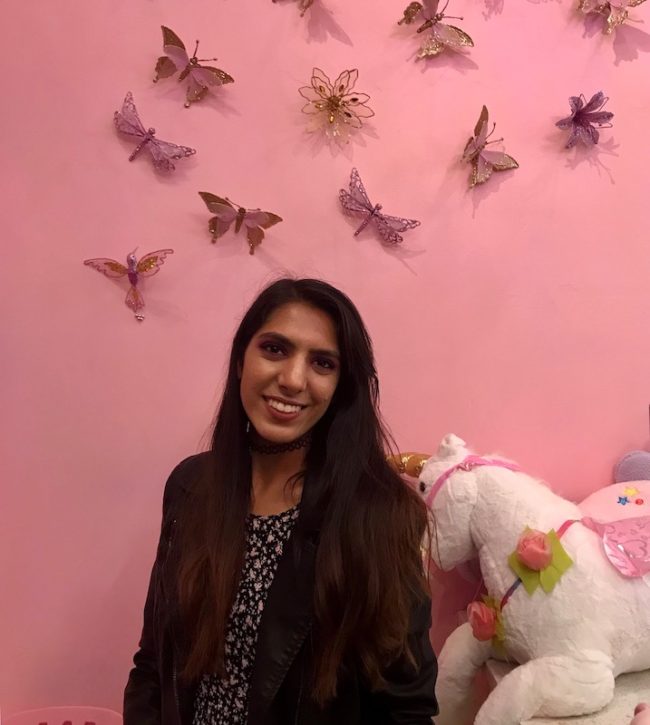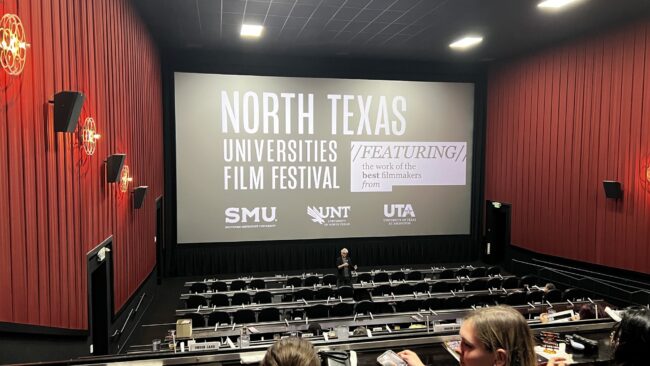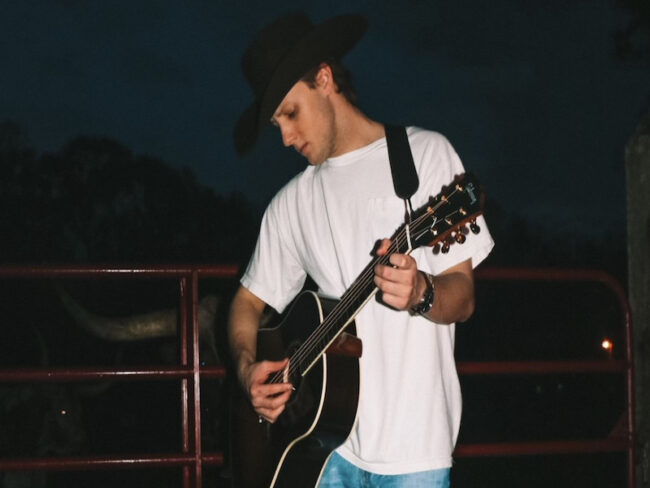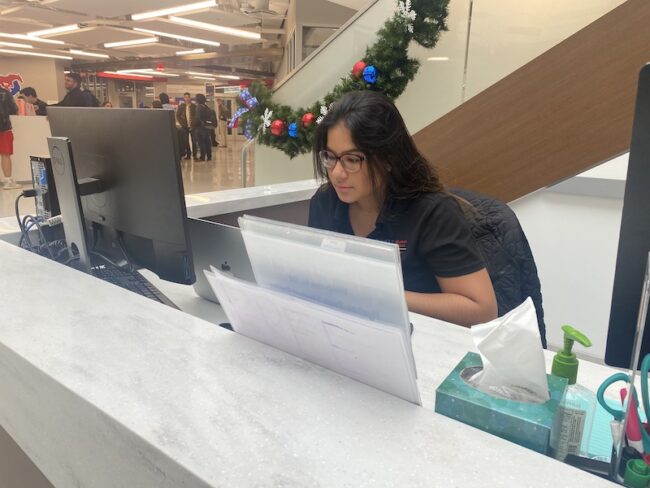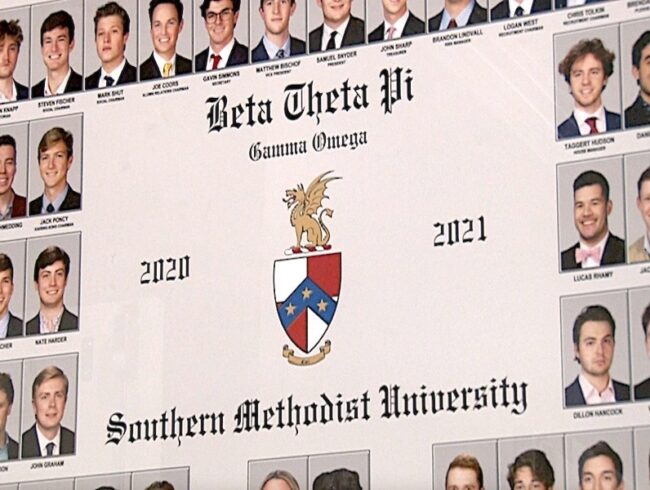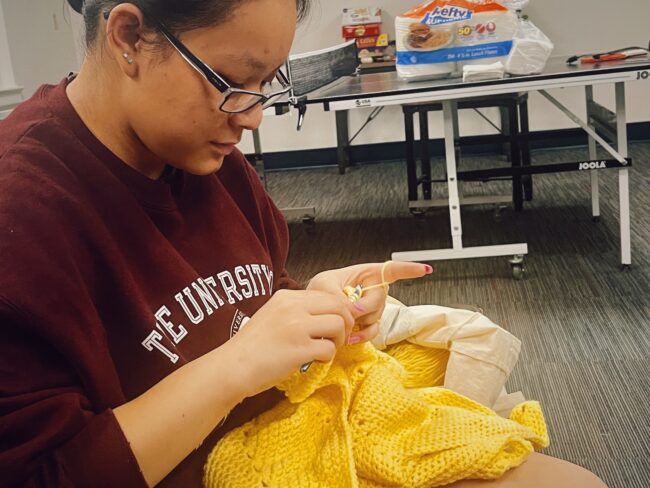Seher Iqbal comes late. She carries a bucket full of sunset orange flowers reminiscent of the autumnal theme of the movie “Coco.” She’s wearing a bright red shirt with the line “Remember My Name” that she got from the last show she acted in (“Fame” with the Plano Youth Theater in 2016.)
She got into a car accident on the way here.
“Are you okay?” Gabby asks. Music therapist Gabby Banzon is the program supervisor for the Starcatchers Program and wrote the script for tonight’s performance. Gabby was first concerned by Seher’s sudden brief email saying she’d be late because of a car accident. Now she was concerned that Seher had actually come after going through an accident. “You didn’t have to come,” Gabby says.
Seher says it hadn’t been that bad– someone had tried to change lanes in her blind spot as she was changing into that same lane, and there’d been confusion as to who was changing first. She says she had to pull over, but no one had gotten hurt.
And like that, she swept the scare away. It does not matter, not in the grand scheme. All that matters tonight is she got here to the theater for the kids.
The Starcatchers Program under North Texas Performing Arts (NTPA) is for children and adults with developmental disabilities. The Fairview branch of the program is specifically for children. Currently, there are four students in this show, each paired with a performance partner. Seher is one of the volunteer performance partners, responsible for helping their respective students face the audience and remember lines.
The theater is bathed in purple-green light. On the far wall is a paper backdrop: a soccer field rendered in Crayon. Stickers represent the masses of spectators around the Crayon soccer field. The Starcatchers will perform an original script Gabby wrote, based on the ideas students pitched to her. The play is a face-off between “Coco” and “Peter Pan” characters in the World Cup.
After the play kids and volunteers will dance to a song popularized during the last FIFA World Cup, as well as to “Remember Me” from the movie “Coco.” The show will be 15 minutes long, equal parts effort and relief for the students.
Seher applied to work with the Starcatchers Program in May 2018. She helped students prepare for the summer performance, which she wasn’t able to attend, and the fall performance. Each Starcatcher is paired with a performance partner volunteer who guides the Starcatcher through the process. An aspiring speech pathologist, Seher always wanted to serve children with developmental and learning disabilities. When she heard about Starcatchers, she knew she had to be a part of it.
“As much as I always wanted to keep the arts in my life, I didn’t realize I could put the two together. Just because there really aren’t that many programs for it,” Seher said.
Madeleine Stevens is a fellow performance partner and Texas Woman’s University music therapy practicum student. She described Seher as “wonderful.” Stevens said, “She was great. She was really helpful. It was a great experience overall working with her. She had a different perspective to bring in since she’s not music therapy. She brought in suggestions more from the theater perspective.”
Seher was, for the most part, quiet and attentive when it came to leading the show alongside Gabby and Madeleine.
“She was kind…of observing me,” Gabby said. “She didn’t bring anything I didn’t already know. Probably if I put her in a different role, like assistant directing, I could give her more to do. She did help with her student, her buddy, on speaking out more and where to stand. She helped on an individual level, and then she helped with the backdrops– what we should put where, and bring supplies for that.”
Seher was indeed observing Gabby. Starcatchers isn’t the beginning of Seher’s long journey combining theater with service– it’s a milestone. Seher hopes to spearhead an initiative to bring acting classes and opportunities to people of disability. This, she calls “Arts for All.”
Similar to Starcatchers, Seher envisioned increasing access to theater for people of disability. She hopes to start by serving people with hearing disabilities. She plans to include having close captioning for theater shows and having hearing actors reciting lines in coordination with deaf actors signing. This would be not only for patrons, but for hearing-impaired actors, directors, and people who work with production. She envisions accommodations as well as theater classes for children with developmental disabilities.
“One of my best friends in high school, who I met in my theater class, is deaf. There would be a joke, and he wouldn’t catch it. Or he would make a joke, and I wouldn’t get it,” Seher said. “As I got to know him and as I learned more sign language, we became really close. And he would tell me it was hard to be as involved in theater when everyone else doesn’t understand you and when it’s hard for people to want to work with you.”
Seher and her friend watched “Spring Awakening,” which was brought back to the stage by the Deaf West Theater in 2014. This production was immensely progressive for its time: it added closed captioning to performances and had hearing characters try to interact with hearing-impaired characters.
“It was one of the most beautiful shows I’ve ever seen, because they seamlessly made– because this was a show written beforehand, all the characters were written as hearing characters– the characters deaf, and it didn’t change the story,” Seher said. “If anything, it made it better, because it enhanced the aspects of Spring Awakening, about communication.”
This example of inclusion on stage helped Seher connect her love for theater to hearing-impaired actors seeking roles.
“Seeing how seamlessly they did it and how happy it made my friend and how it was so amazing we could share this thing– even though it was difficult to enjoy it together because we enjoyed it so differently–it just made me want to have that experience for everyone,” Seher said.
Her love for performance started in the 5th grade, when Seher and her friends improvised plays at recess. The play topics ran the gamut from anti-bullying to a courthouse drama regarding an undependable, sleazy pizzeria employee. Classmates cycled in and out of these silly and fun impromptu performances. Seher and her friends would video tape these plays, and the class would watch them after recess. It was something their classmates looked forward to. One teacher even jokingly called Seher and her friends “movie stars.”
Seher officially started theater in 6th grade with “Annie,” a classic first show for theater kids. With “Annie,” Seher discovered she had a natural advantage with performing.
“I’m that one weird person,” Seher said with a laugh. “Because almost everyone has stage fright. I never had stage fright.”
This would serve her well in the years of performances she would do at her Michigan middle school as well as her Texas middle school, junior high school, and senior high school. Seher moved from Michigan to Texas in 7th grade.
“Which was really hard because middle school sucks anyway. But then having to move right in the middle is the worst. But because I had this connection to theater and the arts, I was able to make friends really fast,” Seher said.
Seher has many a memory of backstage fun, all in accordance with whatever universal laws of chaos dictate pre-show antics for theater kids.
“When you do a show with people, that’s your family. Even if you never see each other again and just follow each other on Instagram, you’re still like ‘I remember her. I love her like she’s my sister,’” Seher said.
In summer of 2018, Seher participated in the Lonestar Institute by Leadershape to develop the vision for her project, as well as Obama Leadership Initiative training to network with other Dallas leaders and visionaries. Seher hopes to learn more about teaching theater students with disabilities by serving with other programs. Seher hopes in the long run to start a 501(c)(3).
“Almost all the schools I went to that I did theater at, you had to be pay to be in the shows. And they’re not cheap. Community theater is generally about $300 to $400 a show. And then school tended to be around $50 or $60 a show,” Seher said. “But, especially in different [geographic] areas, that’s not affordable for everyone. Especially for kids or families with special needs, in a lot of cases, a lot of money goes into treatments, so you don’t have time for that recreation.”
NTPA is a for-profit organization, meaning all the Starcatchers pay to participate in their shows. Seher aims to implement a business model that would support a nonprofit organization doing something similar to Starcatchers, where students wouldn’t have to pay, or at least pay so much, to participate.
During the Starcatchers’ performance, Seher’s student was excited and talkative before the performance. As soon as Gabby begins narrating the performance, the student becomes reticent and hides his face behind the script as parents look on with smiles. He whispers his lines with a nervousness that was not there a minute ago.
Gabby suggests Seher hold the script for her student, and Seher does so. Seher encourages the Starcatcher to stand where the audience can see him. She prompts him with his lines and, afterward, dances with a watchful eye on her student to make sure he does not freeze up during the dance.
Gabby was right: Seher did not have to come on the night of the Starcatchers performance. But her role as performance partner was clearly needed to encourage her student to shine and face the audience. Unable to attend the summer performance, Seher has wanted to attend a Starcatchers performance for a long time. This is her first performance working with actors of disability. She hopes through service and nonprofit work it will not be her last.



